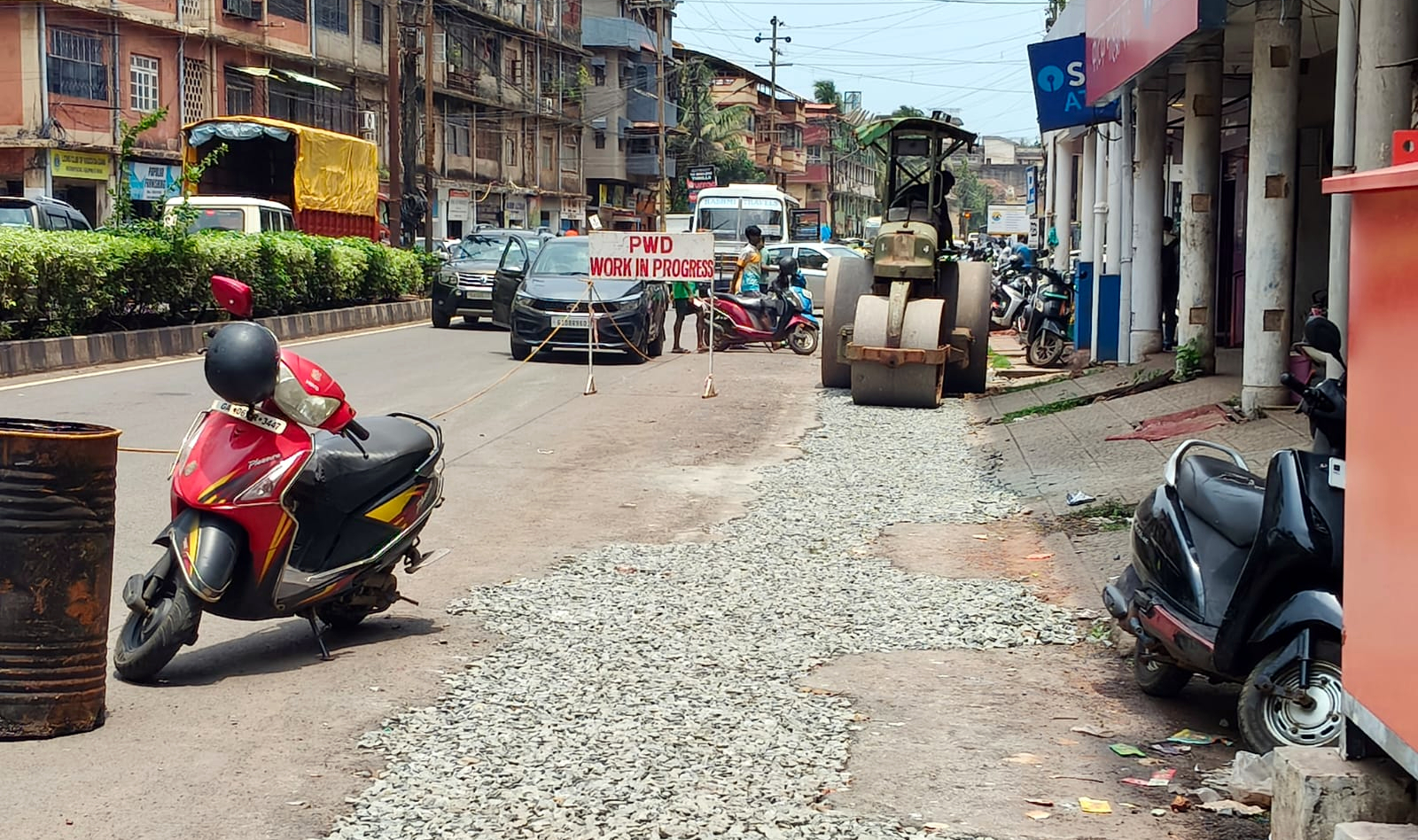
Road trenches being filled with gravel in Vasco.
Photo Credits: Vikram Nayak
VASCO
Once appreciated for its reliable road network, Mormugao taluka has now become a symbol of poor planning and development with painful consequences.
Roads across the constituencies of Vasco, Dabolim and Cortalim have been severely damaged over time – primarily due to infrastructure projects and the constant movement of heavy vehicles.
After months of neglect, repeated complaints, and several serious – in some cases fatal – accidents, authorities have finally begun repair works. But for many, the damage has already been done.
To the surprise of residents and motorists alike, repair and maintenance works began during the monsoon itself – an unusual move by authorities, perhaps spurred by mounting public outcry. While repairs are now underway in many areas, locals say it took a series of disturbing events to prompt action.
The accident toll
Among the incidents linked to damaged roads was a tragic accident in Queeny Nagar, where a passenger bus overturned, killing a cleaner and a commuter while injuring several others.
In another horrific case, a motorcyclist died after falling into an open trench left unattended near an excavation site. Multiple such incidents – especially near ongoing flyover construction zones – have exposed the grave risks posed by poorly managed development.
Vasco: City under construction
In Vasco, roads have been repeatedly dug up for underground cable and pipeline works. With trenches running along both sides of key stretches, the city has turned into a maze of dust, gravel and blocked access. Local businesses have taken a major hit, with many eateries and shops reporting reduced footfall due to unapproachable entrances.
Responding to rising concerns, Vasco MLA Krishna Salkar directed authorities to fill up trenches before the rains. While this helped prevent flooding and averted further accidents, several road shoulders remain dangerously gravel-laden. Poor lighting and uneven surfaces continue to make night travel hazardous.
Salkar has apologised to residents and assured them that the pain is temporary. “We are starting from scratch with underground cabling and water supply works. Roads and footpaths will be restored once the core infrastructure is complete,” he stated.
Dabolim: Highway of hazards
Dabolim’s four-lane highway, particularly the stretch between Vales Junction and MES College, has become a dangerous bottleneck. With a massive Rs 650-crore flyover project underway, the highway has been narrowed down to a single lane.
The absence of service roads, poor signage, unlit zones, and loosely placed barricades have turned this busy route into a danger zone.
Several accidents have occurred here in recent weeks. An electricity department staffer lost his life when a barricade toppled over him. In another case, a person died after falling into a poorly marked pit. A tourist vehicle also plunged into an excavation trench, though thankfully no injuries were reported.
Following protests and police complaints, authorities have taken steps to improve conditions. Some patches have been tarred, signboards installed, and barricades reinforced. Yet, large portions remain riddled with potholes and debris, keeping the threat alive for daily commuters.
Cortalim: Villages cry for attention
In Cortalim, areas like Queeny Nagar, Velsao and Cansaulim have suffered extensive road damage due to flyover-related development. The destruction of a 69-year-old PWD road has particularly angered residents, who accuse the National Highways Authority of India (NHAI) of poor planning and disregard for locals.
Repeated protests forced Cortalim MLA Anton Vas to intervene. The PWD has since promised restoration of damaged stretches, and two-wheeler access has been partially resumed. However, dust and debris remain a constant nuisance, and large sections of the roads are still far from safe. A recent bus mishap in the area further highlighted the fragile condition of the roads and brought renewed attention to the issue.
Growing public unrest
Across Mormugao taluka, the frustration is evident. Lack of coordination between agencies, poor execution of development works, and delayed repairs have brought life to a standstill in many areas.
On World Environment Day, Congress workers staged a symbolic protest in Vasco by planting saplings in potholes. Elsewhere, bus conductors took matters into their own hands by filling potholes with landfill materials. These acts underline the growing public anger and desperation over inaction.
The road ahead
While authorities have now begun addressing the most critical issues – partly in response to tragedies and protests – the road to normalcy will take time. Repair works are ongoing, but full restoration remains weeks, if not months, away.
Residents agree that development is necessary and inevitable. But they are equally vocal about the need for better planning, accountability, and concern for public safety. “We want progress, not pain,” said one shopkeeper in Vasco. “Our lives shouldn’t be the cost of development.”
For now, the people of Mormugao endure daily hardships, hoping that these sacrifices will lead to safer, smarter roads – and a better tomorrow.